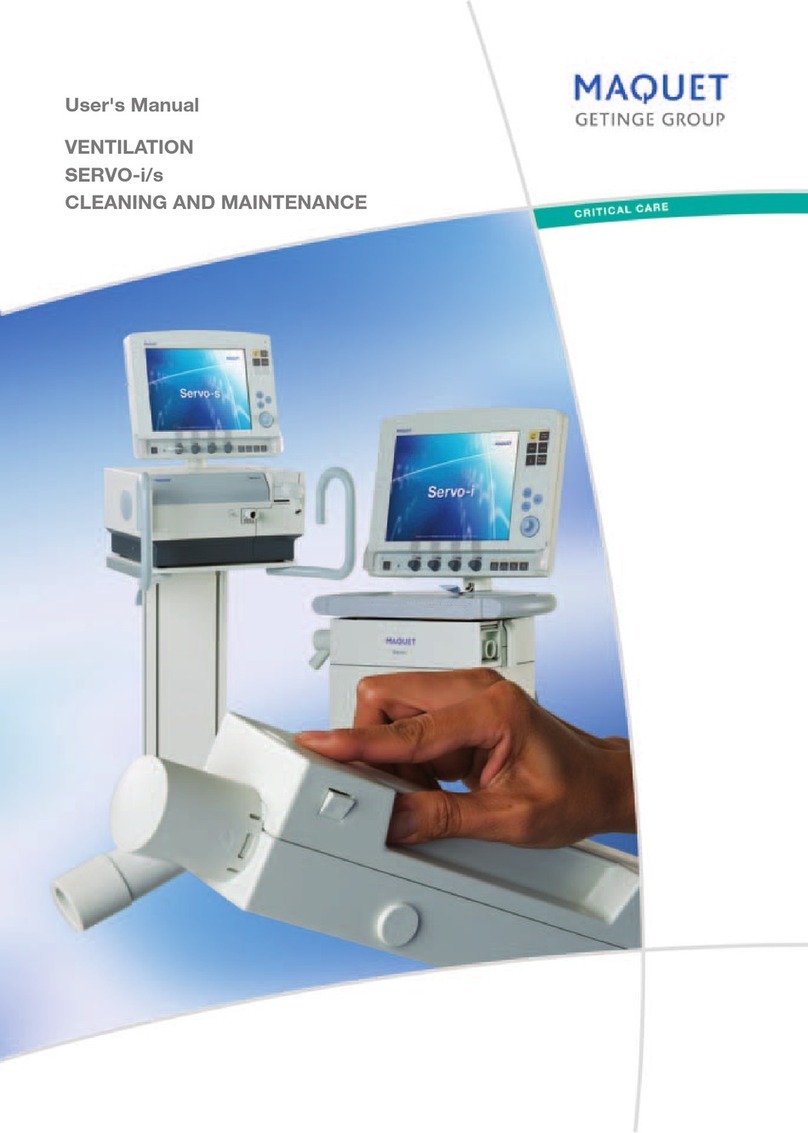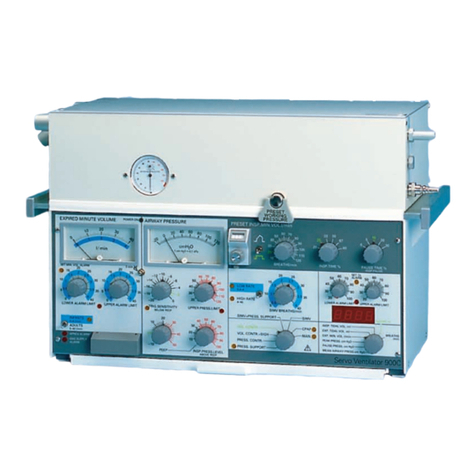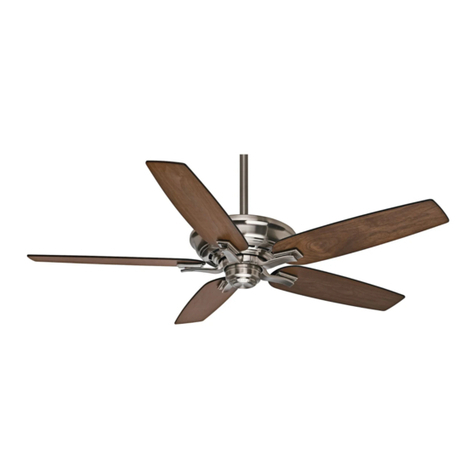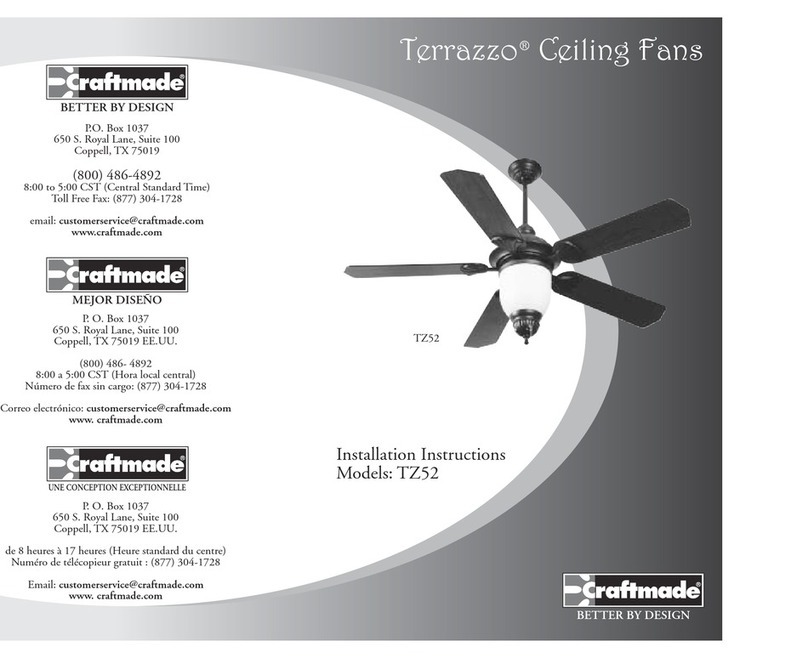Maquet SERVO-air User manual

x
User's Manual
SERVO-air Ventilator System v2.2


TABLE OF CONTENTS
5|Introduction
1
17|System Overview
2
39|Operation overview
3
47|Displaying and saving data
4
57|Ventilation modes
5
85|Ventilatory settings and functions
6
111|Alarm handling
7
125|Service & Settings
8
133|Technical data
9
161|Index
10
SERVO-air Ventilator System v2.2, User's Manual
Infologic 1.48 3
| TABLE OF CONTENTS |

4SERVO-air Ventilator System v2.2, User's Manual
Infologic 1.48
| TABLE OF CONTENTS |

1.1 Device description
1.1.1 Device components
The ventilator system consists of:
1. a user interface for setting ventilation
modes, displaying data and indicating
alarms
2. a patient unit for mixing gases and
controlling gas delivery
3. a patient circuit for delivering and
exchanging gases
1
23
1.1.2 Intended use
The SERVO-air Ventilator System is:
•intended for respiratory support, monitoring
and treatment of pediatric and adult
patients
•to be used only by healthcare providers
•to be used only in professional healthcare
facilities and for transport within these
facilities
6SERVO-air Ventilator System v2.2, User's Manual
| 1| Introduction |

1.1.3 User's Manual
This manual summarizes the functions and
safety features of the ventilator system. It is
not all-inclusive and should not be seen as a
substitute for training.
1.1.4 Cleaning & Maintenance
Please refer to the SERVO-air Cleaning and
Maintenance User's Manual.
1.1.5 Servicing Guidelines
CAUTIONS:
•Regular Service: The ventilator system
must be serviced at regular intervals by
personnel who have received
authorization and specialized training by
the manufacturer.
•Complete service records: All service
performed on the ventilator system must
be recorded in a service log in
accordance with hospital procedures and
local and national regulations.
•Service Contract: It is strongly
recommended that all service on the
ventilator system should be performed
as part of a service contract with the
manufacturer.
Note: If the ventilator system is to be a part
of another system it requires an evaluation
of the requirements of the IEC 60601-1
standard.
1.1.6 Disclaimers
Non-professional servicing:
The manufacturer has no responsibility for the
safe operation of the ventilator system if
installation, service or repairs are performed
by persons other than those authorized by the
manufacturer.
SERVO-air Ventilator System v2.2, User's Manual 7
| Introduction | 1|

1.2 Safety guidelines
Follow these safety guidelines. Additional
warnings appear in context throughout this
document.
Information is highlighted with Warning,
Caution, Important or Note, where:
WARNING! Indicates critical information
about a potential serious outcome to the
patient or the user.
CAUTION: Indicates instructions that must
be followed in order to ensure the proper
operation of the equipment.
Important: Indicates information intended
as help to operate the equipment or its
connected devices easily and conveniently.
Note: Indicates information requiring special
attention.
1.2.1 General
WARNINGS!
•The ventilator system may be operated
only by authorized personnel who are
properly trained in its use. It must be
operated according to the instructions in
this User´s Manual.
•After unpacking, perform a routine
cleaning and a pre-use check.
•Always perform a pre-use check before
connecting the ventilator system to a
patient.
•Secure all tubing and cables to avoid the
risk of unwanted movement of the
equipment.
•If any of the following occurs, discontinue
use of the ventilator system and contact
a service technician:
- unfamiliar pop-up windows on the
screen
- unfamiliar sounds
- any unfamiliar or unexplained event
- alarms that cannot be resolved
•Make sure that a resuscitator is readily
available.
•The air inlet must not be occluded.
•Positive pressure ventilation can be
associated with the following adverse
events: barotrauma, hypoventilation,
hyperventilation or circulatory
impairment.
•Ventilation must be started manually
when a patient is connected to the
ventilator system.
•Keep the ventilator system upright during
use.
8SERVO-air Ventilator System v2.2, User's Manual
| 1| Introduction |

•Do not cover the ventilator system in any
way, since the functioning of the
equipment may be adversely affected.
•Do not modify or remove any original
parts.
•The ventilator system must not be used
during radiotherapy, since this may cause
system malfunction.
•The ventilator system must not be used
in a hyperbaric chamber.
•The ventilator system must be kept away
from magnetic resonance imaging (MRI)
equipment.
•The ventilator system must not be used
with helium or any gas mixture containing
helium.
•When the ventilator system is used with
MCare Remote Services, use only
network equipment that is safe and
complies with the relevant electrical and
EMC standards such as IEC 60950.
Note:The network cable is excluded
from this requirement.
•Only accessories, supplies, and auxiliary
equipment recommended by the
manufacturer should be used with the
ventilator system. Use of any other
accessories, spare parts or auxiliary
equipment may cause degraded system
performance and safety.
•Use only active humidifiers approved by
the manufacturer of the ventilator system.
Use of non-approved active humidifiers
may result in higher gas temperatures
and increase resistance in filters.
•During humidification, carefully monitor
the airway pressure. Increased airway
pressure could result from a clogged
filter. Replace the filter if the expiratory
resistance increases or according to the
instructions for the filter, whichever
comes first.
•Service, repair and installation must only
be performed by personnel authorized
by the manufacturer.
•The ambient sound needs to be taken
into consideration when setting the alarm
sound level.
•Always disconnect the patient from the
ventilator system when performing
operations that involve risk for the
patient, such as replacing the O2cell,
dismantling etc.
•Portable RF communications equipment
(including peripherals such as antenna
cables and external antennas) should be
used no closer than 30 cm (12 inches) to
any part of the SERVO-air Ventilator
System including cables specified by the
manufacturer. Otherwise degradation of
this equipment could result.
CAUTIONS:
•Never leave the patient unattended when
connected to the ventilator system.
•Before use, make sure the system
version displayed under SYSTEM
STATUS/General corresponds to the
system version described in the User's
Manual.
•The manufacturer has no responsibility
for the safe operation of the ventilator
system if the requirements specified in
Intended use on page 6 are not
followed.
SERVO-air Ventilator System v2.2, User's Manual 9
| Introduction | 1|

•When lifting or moving the ventilator
system or parts of the system, follow
established ergonomic guidelines, ask
for assistance, and take appropriate
safety precautions. The weight is
specified on the ventilator system.
•The air inlet filter must be in place when
the system is running.
•The expiratory channel and expired gas
from the exhaust port may be
contaminated.
•If a scavenging system (i.e. gas
evacuation) is connected to the ventilator
system, it must conform to ISO
80601-2-13 guidelines for
subatmospheric pressure and induced
flow.
•During operation any water traps must
be checked regularly and if necessary
emptied.
•All technical documentation is available
for use by personnel authorized by the
manufacturer.
•When using the MCare Remote Services
function, instal the network cable so that
there is no risk of anyone tripping over
it.
•The ventilator system must not be used
with any anaesthetic agent.
Important:
•Securely attach all cables, etc, to
minimize the risk of unintentional
disconnection.
•While the ventilator system is in use, the
wheels of the mobile cart must be locked
and the mobile cart must be in a
horizontal position.
•When the ventilator system is connected
to a patient:
- Do not lift or disconnect the expiratory
cassette.
- Continuously monitor the settings and
measurements displayed on the
screen.
•Always use a heat and moisture
exchanger (HME) or an active humidifier
to prevent dehydration of lung tissue.
•If a heated patient circuit is not used in
the system, a water trap must be used
on the expiratory tube to avoid
condensation in the system when an
active humidifier is used. During
operation the water traps must be
checked regularly and if necessary
emptied.
•Check that the cooling fan intakes are
not covered. Do not place the ventilator
system on soft surfaces.
•The air inlet filters must be checked
regularly and replaced if necessary.
•Use an inspiratory filter when ventilating
a highly infectious patient.
•All excess fluids must be disposed of
according to hospital routines.
•The emergency air intake must not be
blocked.
•Do not disconnect the expiratory
cassette while the ventilator system is in
operation; if necessary, disconnect the
cassette while in STANDBY.
10 SERVO-air Ventilator System v2.2, User's Manual
| 1| Introduction |

Notes:
•Do not simultaneously touch the patient
and any accessible connector contacts.
•Do not solely rely on the use of an
external monitor to determine the status
of the patient and the ventilator system.
•Make sure that the ventilator system is
firmly mounted on the mobile cart.
•Make sure that cables and patient circuit
is not obstructed or squeezed due to
improper mounting.
•Extra care should be taken when
handling tubes, connectors and other
components of the patient circuit.The
use of a support arm to relieve the patient
from the weight of the tubing system is
recommended.
•Contact a representative of the
manufacturer regarding decommissioning
of the equipment.
•Expiratory filter connection is mandatory
during nebulization.
•A water trap is recommended if a single
heated patient circuit is used.
•Thermoshell, expiratory cassette must
be used when using heated expiratory
tubing or Expiratory heater Servo Duo
Guard.
1.2.2 Power supply
WARNINGS!
•The power cord must be connected only
to an AC mains power outlet with
protective earth to avoid the risk of
electric shock.
•The power supply cord must be plugged
directly into the mains power outlet
without the use of any multiple socket
outlets. If a multiple socket outlet is used
together with other products, total
leakage current might be exceeded in
the event of a fault in the protective earth.
CAUTIONS:
•Do NOT use antistatic or electrically
conductive tubing with this system.
•Avoid contact with external electrical
connector pins.
SERVO-air Ventilator System v2.2, User's Manual 11
| Introduction | 1|

Important: In case of total loss of power
during ventilation, an alarm will sound for 2
minutes. When power is restored, the
ventilator system will start in the same state
and with the same settings as before the
power loss.
Note: When the system is connected to an
external power supply, all connected battery
modules are being recharged. This does
not affect ventilation.
Battery
WARNINGS!
•Do not use sharp tools when extracting
the batteries.
•To guarantee reliable battery backup,
make sure a battery is in place in slot 2
at all times during ventilation.
•Dispose of batteries according to local
regulations and not with ordinary waste.
CAUTION:
The battery modules must be charged
before first use.
Do not expose the batteries to water, fire
or excessive heat.
Do not crush, disassemble, puncture or
short circuit the connector terminals.
One battery can be added to an available
slot during operation.
Hold onto the battery strap when inserting
a battery in the ventilator system.
Important:
•If a battery status message is displayed
on the screen, always go to SYSTEM
STATUS/Batteries for detailed
information.
•Check battery in SYSTEM
STATUS/Batteries window to ensure safe
battery operation. Always charge the
battery before use.
•Always replace batteries when the
ventilator system provides notification of
imminent expiration or of diminished
operating capacity.
•When not in use, the ventilator system
should always be connected to the mains
power to ensure fully charged batteries.
Refer to section Battery status on page 25.
12 SERVO-air Ventilator System v2.2, User's Manual
| 1| Introduction |

1.2.3 Fire hazard
WARNINGS!
•Keep all sources of ignition away from
the ventilator system and the oxygen
hoses.
•Do not use a ventilator system with worn
or frayed gas supply hoses or hoses that
have been contaminated by combustible
materials such as grease or oil.
•Oxygen-enriched gas is extremely
flammable: if a burning odor is detected,
disconnect the oxygen supply and mains
power and remove the batteries.
•Make sure that both the mains power
outlet and the power supply connector
are accessible.
1.2.4 Gases
WARNING! The ventilator system must not
be used with helium or any gas mixture
containing helium.
Refer to section Ventilator system on page 136.
1.2.5 Auxiliary equipment
CAUTION:
Measurements of numerical values that
have been processed by auxiliary
equipment:
•may be inaccurate if equipment not
authorized by the manufacturer is used
•should be disregarded if they conflict
with information on the ventilator screen
•must not be used as a substitute for
therapeutic or diagnostic decisions.
Accessories, supplies, and auxiliary equipment
used with the ventilator system must be
recommended by the manufacturer
SERVO-air Ventilator System v2.2, User's Manual 13
| Introduction | 1|

1.2.6 Electromagnetic Compatibility
Important: The ventilator system must be
installed and put into service according to
Electromagnetic Compatibility, SERVO-air
Ventilator System.
In order to ensure that the SERVO-air
Ventilator System, during electromagnetic
disturbances, will deliver ventilation at the
connection port within the alarm limits set by
the user, or generate an alarm condition, the
following essential performance (IEC 60601-1)
has been monitored during electromagnetic
immunity tests:
•Delivered volume
•Monitoring of:
Oxygen concentration-
- Airway pressure
- Expired volume
- Internal electrical power source
- Mains power status
- Gas supply
- Gas temperature
•Ability to generate alarms
No degradation or failure of the essential
performance has been observed during these
tests.
No other effects on the ventilator system have
been observed during the electromagnetic
immunity tests.
14 SERVO-air Ventilator System v2.2, User's Manual
| 1| Introduction |

1.3 Version and configurations
This manual applies to version 2.2 of the SERVO-air Ventilator System.
1.3.1 Configurations
The ventilator system can be used in both invasive and non invasive ventilation.
The configurations includes adult and pediatric.
Refer to section System on page 134.
1.3.2 Available modes and functions
Patient categoryModes/Functions
AdultPediatric
XXPC
OOPRVC
XXVC
OOBi-Vent/APRV
XXPS/CPAP
OOVS
OOAutomode
X
O
X
X
O
X
SIMV
•(PC) + PS
•(PRVC) + PS
•(VC) + PS
OONIV PC
OONIV PS
XXNebulizer
OOAlarm output connection
O = option— = not applicableX = standard
SERVO-air Ventilator System v2.2, User's Manual 15
| Introduction | 1|

16 SERVO-air Ventilator System v2.2, User's Manual
| 1| Introduction |

2.1 Ventilator
The ventilator consists of a user interface and
a patient unit.
Air is supplied from ambient air by an internal
turbine and O2may be supplied by a medical
pipeline system or by gas cylinder.
2.1.1 Mounting on mobile cart
•Lock the wheels.
•Release the locking clamp on the mobile
cart.
•Stand directly in front of the mobile cart
when mounting the ventilator system.
•Tilt the ventilator system to fit the two front
clamps in position on the mobile cart.
•Press down the rear end of the ventilator to
fit the rear clamp in position.
•Lock the ventilator system to the mobile
cart with the locking clamp.
•Ensure that the patient unit is firmly fixed
to the mobile cart via the clamps and
locking clamp.
18 SERVO-air Ventilator System v2.2, User's Manual
| 2| System Overview |

4
1
11
2
3
57
6
9
10
8
1. Patient unit
2. User interface
3. Expiratory inlet
4. Inspiratory outlet
5. Emergency air intake
6. Air inlet
7. Battery compartment
8. Patient circuit
9. AC mains power
10. O2 supply
11. Wheel lock
Note: Lock the wheels whenever the
ventilator system is standing still.
SERVO-air Ventilator System v2.2, User's Manual 19
| System Overview | 2|

2.2 Patient unit
1
2
16
4
15
6 8 9 10 17
7
3
11
12
13
14
18
21
5
20
19
1. On/Off switch
The switch must be pulled downwards
before it can be switched.
2. Expiratory outlet
3. Power indicators
4. RS-232 connectors
5. Equipotentiality terminal.
6. AC mains power source connector with
fuse
7. Alarm output connection
8. External +12V DC inlet
9. Fuse for external DC power
10. Ethernet connection
11. Battery compartments
12. USB ports
13. Gas inlet for O2
14. Gas inlet for air including air inlet filter
15. Inspiratory outlet
16. Emergency air intake
17. Nebulizer connector
18. Expiratory inlet
19. Cooling fan with filter (on both sides)
20. Expiratory cassette
21. Expiratory inlet with moisture trap
20 SERVO-air Ventilator System v2.2, User's Manual
| 2| System Overview |
Other manuals for SERVO-air
1
Table of contents
Other Maquet Fan manuals
Popular Fan manuals by other brands
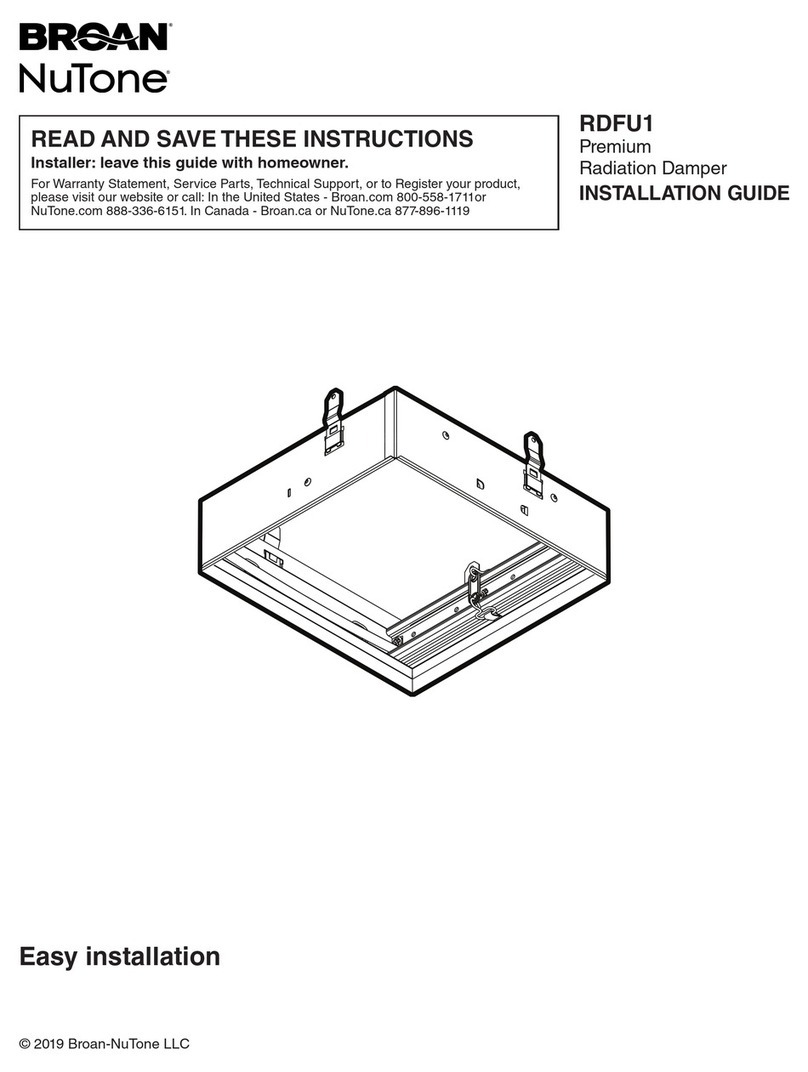
NuTone
NuTone RDFU1 installation guide

Xpelair
Xpelair GX12 Installation and operating instructions
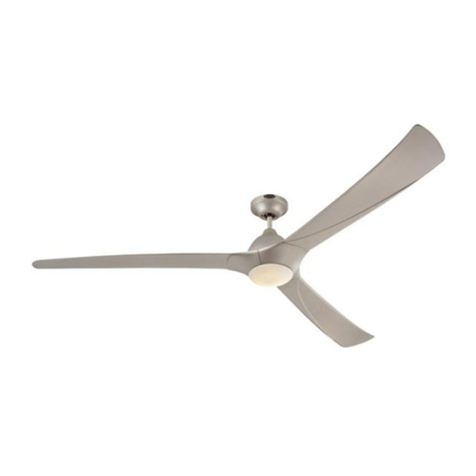
Westinghouse
Westinghouse Techno II manual
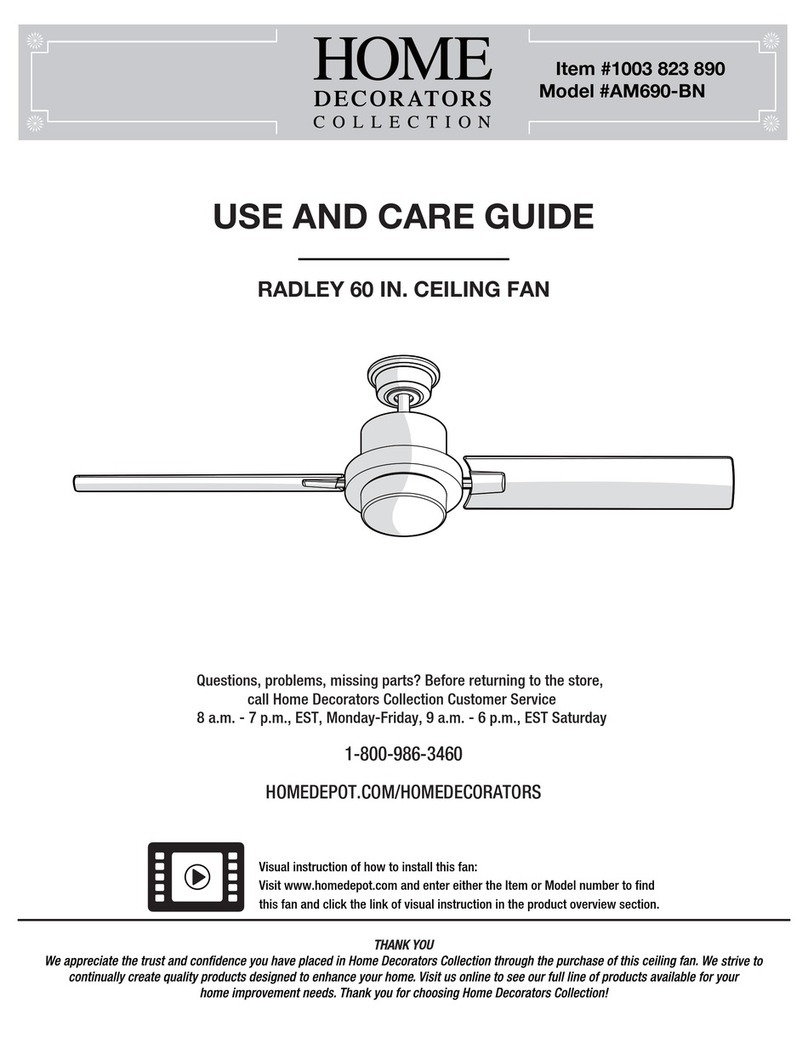
Home Decorators Collection
Home Decorators Collection RADLEY AM690-BN Use and care guide
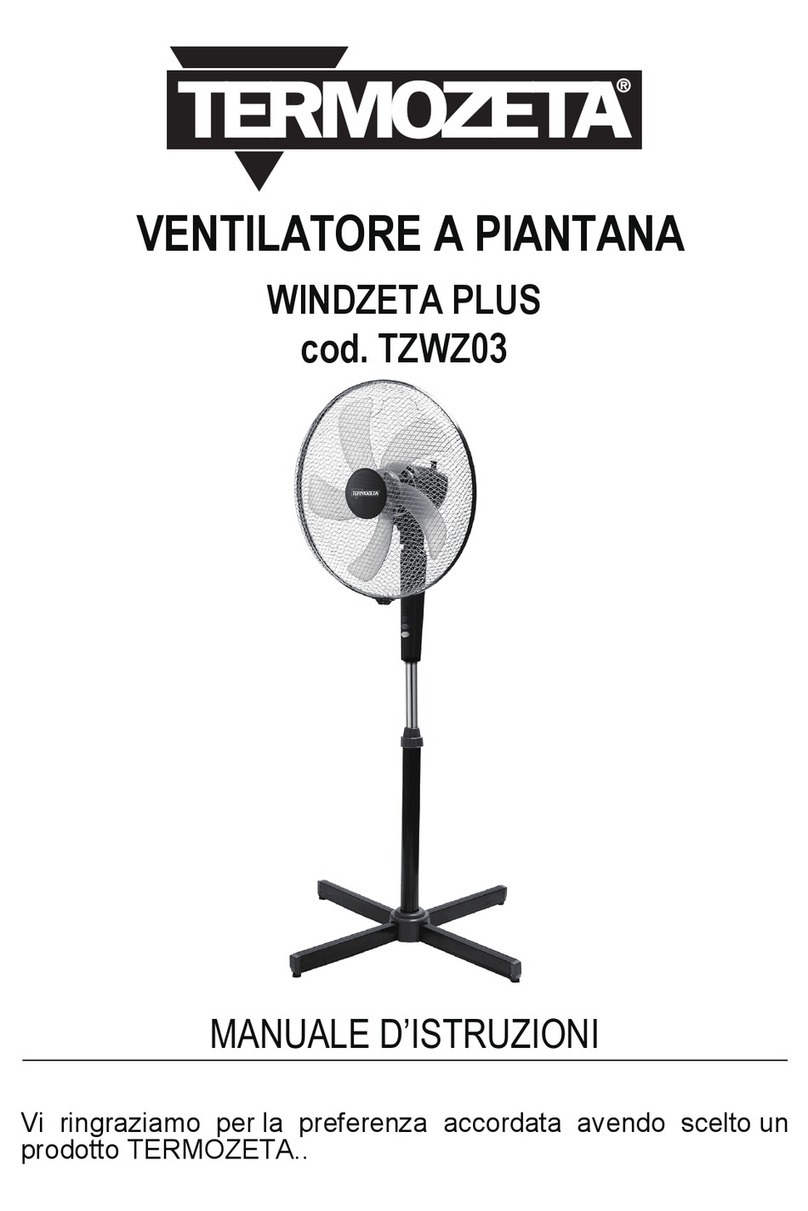
Termozeta
Termozeta WINDZETA PLUS instruction manual
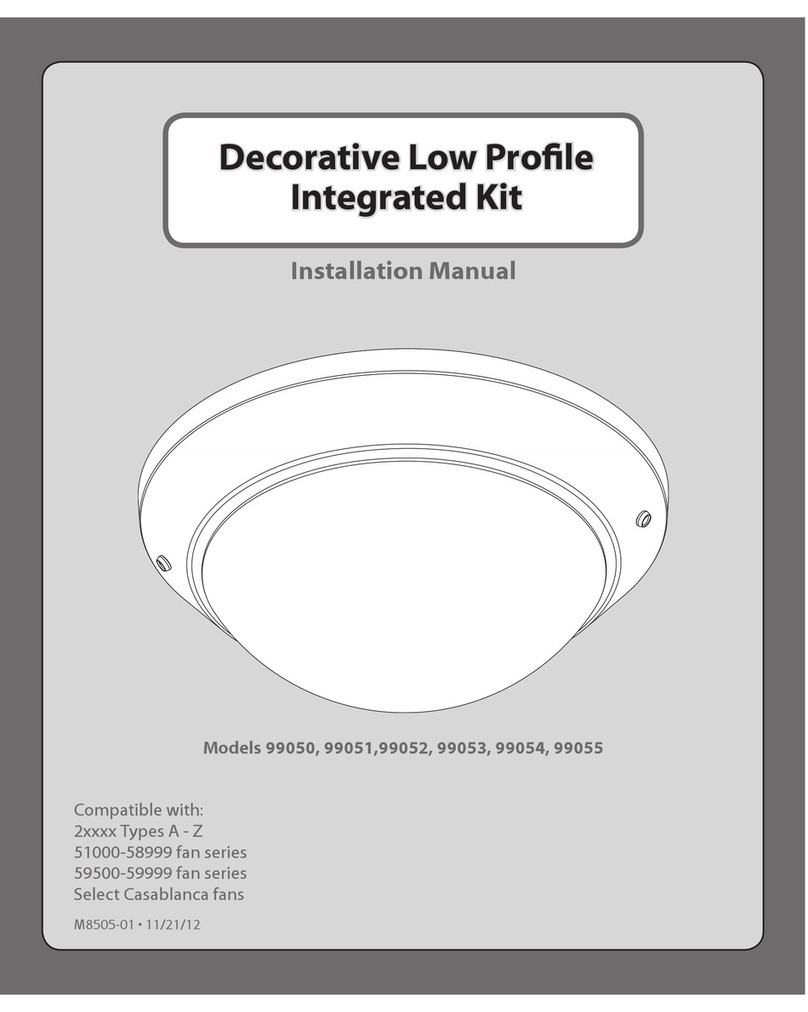
Casablanca
Casablanca 99050 installation manual

Seifert
Seifert 3BHB029034R0101 user manual
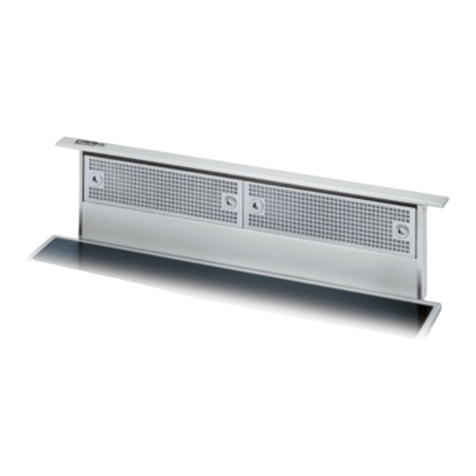
Viking Range
Viking Range RDIPR101R manual
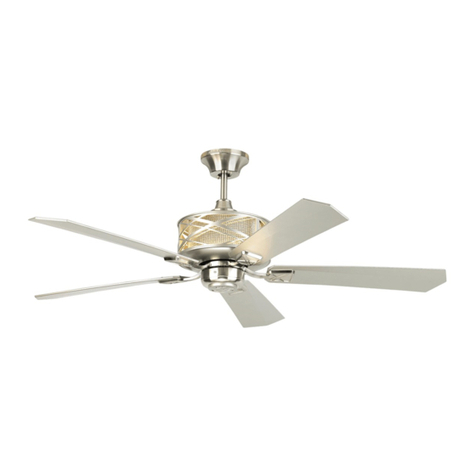
Monte Carlo Fan Company
Monte Carlo Fan Company 5PPR54 Series Owner's guide and installation manual
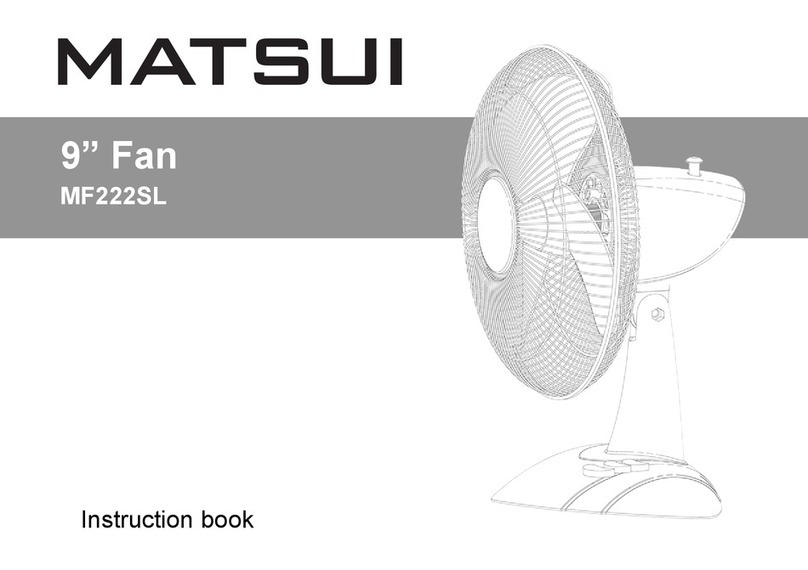
Matsui
Matsui MF222SL Instruction book
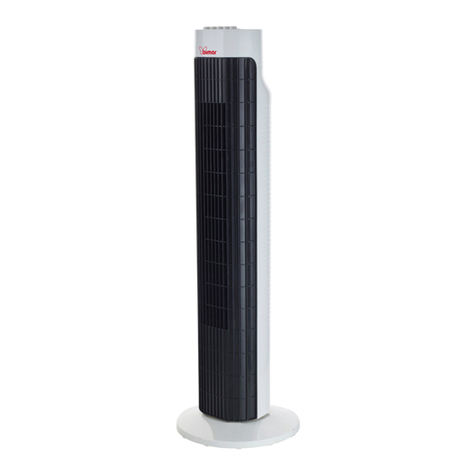
Bimar
Bimar VC99 Instruction booklet

Kichler Lighting
Kichler Lighting Compass 300322 instruction manual


